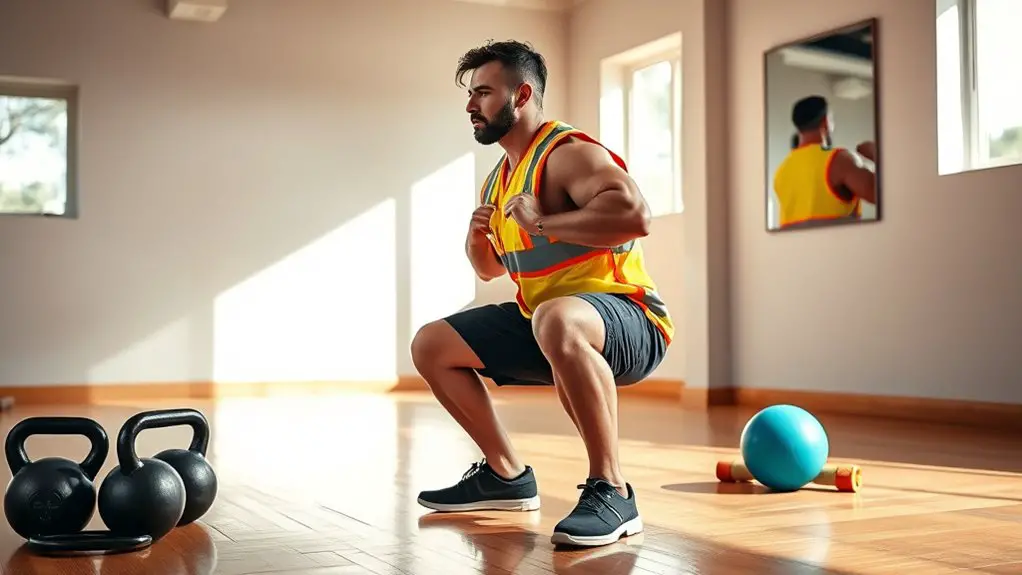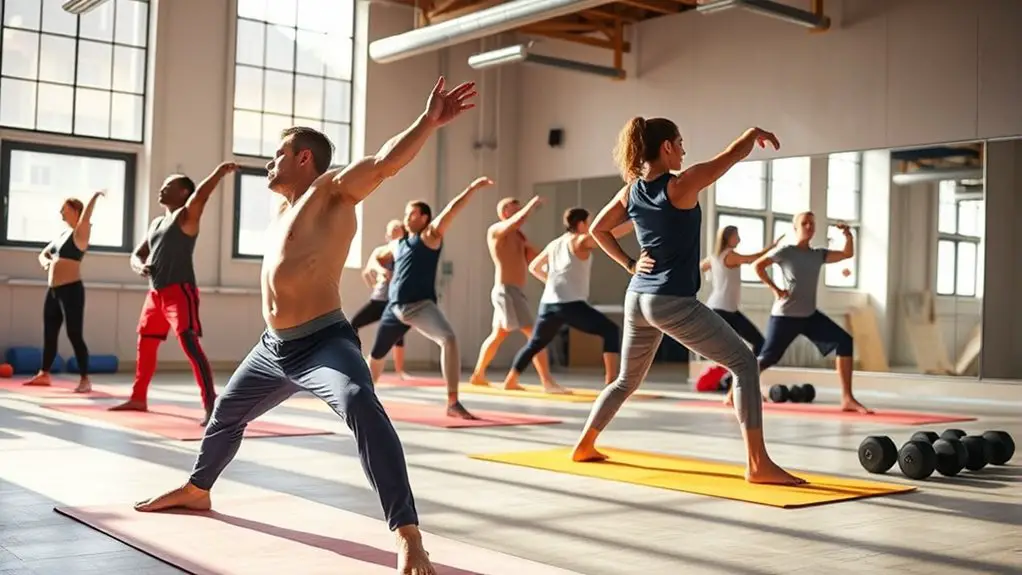Best Gym Exercises for Construction Workers to Prevent Injuries

To prevent injuries, you should focus on strength training, core exercises, and flexibility drills. Incorporate bodyweight squats, planks, and medicine ball workouts to build muscle endurance and joint support. Don’t forget upper body exercises like bench presses and rows to enhance lifting efficiency. Dynamic stretches will improve your flexibility and mobility. These workouts not only reduce fatigue but also boost your overall performance on the job. Stay tuned to discover more effective strategies for injury prevention.
Importance of Strength Training for Construction Workers

When you work in construction, strength training isn’t just a good idea—it’s vital. Building strength offers numerous benefits that directly contribute to your safety on the job. By engaging in a regular strength training program, you enhance your muscle endurance, which is essential for long hours of physical labor. This improved endurance helps prevent fatigue, a significant factor in workplace injuries.
Furthermore, strength training is key to injury prevention. Strong muscles support your joints, reducing the risk of strains and sprains common in construction work. By focusing on exercises that target major muscle groups, you’ll improve your overall stability and coordination, making it easier to navigate challenging environments.
Incorporating strength training into your routine not only boosts your physical capabilities but also fosters a safer work environment. So, prioritize strength training to guarantee you’re fit and ready to tackle the demands of your construction job.
Core Exercises for Stability and Support
Building a strong core is essential for stability and support on the job site. Incorporating plank variations and medicine ball exercises into your routine can greatly enhance your core strength. Let’s explore how these exercises can benefit your performance and overall safety.
Plank Variations for Strength
Although core strength is often overlooked, it’s essential for construction workers who need stability and support in their daily tasks. Plank variations are a great way to build this strength and can greatly enhance your performance on the job. Start with basic planks, then progress to side planks or plank jacks for added challenge. Each plank progression offers unique benefits, such as improved balance and reduced risk of injury, which are vital for your safety. Incorporating these exercises into your routine can strengthen your core, leading to better posture and endurance while you work. Remember, a strong core supports your entire body, making it easier to handle the physical demands of construction work safely.
Medicine Ball Exercises
Medicine ball exercises are fantastic for enhancing core stability and overall strength, making them ideal for construction workers. Incorporating medicine ball variations into your routine can help you build a resilient core, which is essential for preventing injuries on the job. For instance, try the medicine ball Russian twist to improve rotational strength or the wall ball toss to enhance power. These exercises not only strengthen your core but also improve your balance and coordination, translating to better performance at work. The medicine ball benefits extend beyond the gym, as a strong core supports your back during heavy lifting and awkward movements. So grab a medicine ball and start incorporating these exercises for a safer, more effective workday!
Lower Body Workouts to Prevent Strains

When you’re on the job site, the last thing you want is to deal with lower body strains that can sideline you. Incorporating effective lower body workouts into your routine can greatly reduce this risk. Start with squat variations, like bodyweight squats or goblet squats, to strengthen your legs and improve balance. These exercises mimic movements you’ll encounter on the job, enhancing your stability.
Next, don’t overlook leg presses. This exercise targets your quadriceps, hamstrings, and glutes, providing a solid foundation for lifting and carrying heavy materials. Aim for a moderate weight that allows for controlled movements, focusing on proper form to prevent injury. Additionally, introducing reverse curls into your workout can help strengthen your biceps and forearm muscles, which are crucial for lifting tasks.
Combining these exercises will help you build the strength and endurance needed to tackle daily tasks safely. Always prioritize your safety and listen to your body; if something feels off, take a break and reassess.
Upper Body Strengthening for Lifting Efficiency
Boost your lifting efficiency by incorporating upper body strengthening exercises into your routine. A strong upper body helps you develop better lifting techniques, which can considerably reduce your risk of injury on the job. Focus on exercises like bench presses, rows, and shoulder presses to build muscle in your chest, back, and shoulders. These muscles play an essential role in stabilizing your body and supporting heavy lifts.
Don’t forget about the importance of grip strength; incorporating exercises like dead hangs or farmer’s walks can enhance your ability to hold onto tools and materials securely. Aim for two to three sessions a week, allowing for adequate recovery. Remember, it’s not just about lifting heavier; it’s about lifting smarter. By strengthening your upper body, you’ll not only improve your efficiency but also promote long-term safety and health in your physically demanding work environment.
Flexibility and Mobility Drills for Injury Prevention

Building upper body strength is important, but it’s equally essential to focus on flexibility and mobility to prevent injuries on the job. Incorporating dynamic stretching and joint mobility drills into your routine can greatly enhance your range of motion and reduce the risk of strains.
Here’s a simple table to guide you:
| Drill | Purpose |
|---|---|
| Arm Circles | Improves shoulder mobility |
| Leg Swings | Enhances hip flexibility |
| Torso Twists | Increases spinal mobility |
| Ankle Rolls | Boosts ankle joint flexibility |
| Dynamic Lunges | Engages lower body and hip joints |
Recovery Techniques to Enhance Performance and Reduce Fatigue
To guarantee you’re performing at your best and minimizing fatigue, incorporating effective recovery techniques into your routine is essential. Active recovery, such as light walking or cycling, helps to improve blood flow and reduce muscle soreness without putting additional strain on your body. This approach keeps your muscles engaged while allowing them to recover.
Additionally, foam rolling is a fantastic tool for alleviating tightness and improving flexibility. By targeting trigger points, you can release tension in your muscles, leading to quicker recovery times and enhanced performance. Spend a few minutes each day using a foam roller on areas that feel stiff or sore. It’s also important to consult a doctor if you experience pain while exercising to rule out serious injuries.
Frequently Asked Questions
How Often Should Construction Workers Train at the Gym?
You should aim for a training frequency of at least three times a week to build strength and endurance. Workout consistency is key in preventing injuries and keeping you fit for demanding tasks. It’s important to listen to your body; if you’re feeling fatigued, don’t hesitate to adjust your schedule. Remember, quality over quantity matters—focus on effective exercises that enhance your overall safety and performance on the job. Your well-being is worth it!
What Are the Best Warm-Up Exercises Before Workouts?
Did you know that nearly 70% of injuries could be prevented with proper warm-ups? Before your workout, you’ll want to prioritize dynamic stretches and mobility drills. These exercises not only increase your range of motion but also prepare your muscles for the demands of your workout. Incorporate movements like leg swings and arm circles to get your blood flowing. Remember, a solid warm-up can set the tone for a safe and effective training session!
Should Construction Workers Use Supplements for Muscle Recovery?
When it comes to muscle recovery, you might wonder if supplements are necessary. While some supplement types, like protein powders and amino acids, can aid recovery, they’re not always essential. It’s vital to prioritize natural recovery methods, like proper hydration and balanced nutrition. If you decide to use supplements, consult a healthcare professional to guarantee they fit your needs and won’t interfere with any safety protocols on the job site. Your well-being matters!
How Can I Track My Progress Effectively?
Tracking your progress effectively is essential for your fitness journey. Start with clear progress indicators like weight lifted, reps completed, or body measurements. You can also incorporate fitness journaling; jot down your workouts, how you felt, and any improvements. This helps you stay motivated and spot patterns over time. Remember, consistency is key, and reflecting on your progress not only boosts confidence but also guarantees you’re training safely and effectively.
What Should I Do if I Feel Pain During Exercise?
If you’re feeling pain during exercise, it’s not your body’s way of saying, “Keep going, champ!” It’s more like a neon sign flashing “Stop!” In the world of pain management, listening to your body is key. Modifying your exercises can save you from long-term trouble. Don’t be a hero—opt for lighter weights or switch to low-impact moves. Remember, safety first! You can still get fit without turning your workouts into a wrestling match.





